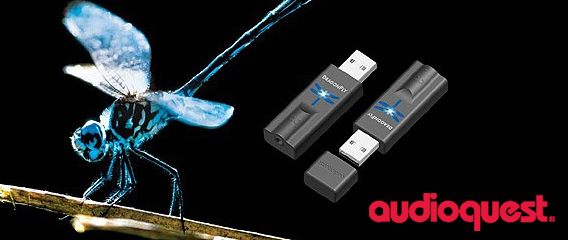You may have heard some “buzz” in the consumer electronics industry about AudioQuest’s latest project, DragonFly. If you joined us for our Spring Expo, you may recall the prototype that AudioQuest presented. You may have even been lucky enough to listen to a demo. DragonFly is coming soon, but before it gets here, we thought you might like to know more about it.
Meet DragonFly
DragonFly is an affordable and easy-to-use device that delivers far superior sound by bypassing the poor quality sound card that is built into your computer. DragonFly is a sleek, flash drive sized Digital-Audio Converter that connects to a USB jack on a Mac® or Windows® PC, turning any computer into a true high-fidelity music source.
Whether you’re on the go or at home, listening on ear buds or connecting your computer to a stereo system, DragonFly reveals all the emotional expression and nuance that makes your favorite music, or movies, so enjoyable.
True high-fidelity audio has been restricted to our home stereos and home entertainment systems for generations. DragonFly is a 21st century hi-fi component that offers breakthrough price and performance. Getting truly great sound from any computer is now not only possible, it’s portable.
What is a Digital-Audio Converter (aka “DAC”)?
Anytime you’re listening to music, or watching a movie or YouTube video on a computer, the digital audio files being played are comprised of streams of 1’s and 0’s. A Digital-Audio Converter is a device that converts these 1’s and 0’s to the analog waveforms that our headphones and home stereos then give to our ears as music. The sound card that’s built into your computer and feeds its headphone jack is an example of a DAC. However, much better sound is possible using a purpose-built Digital-Audio Converter like AudioQuest’s DragonFly.
What DragonFly Does
DragonFly’s 3.5mm mini-jack output is highly versatile, and supports a variety of output modes depending on how it’s connected.
- DragonFly drives headphones or ear buds directly
- DragonFly can be used in “variable” output mode with analog volume control when connected directly to powered speakers or a power amplifier.
- Connecting to a traditional preamplifier or AV receiver, DragonFly can be set to a “fixed” output mode by turning the volume to maximum, allowing it to behave like a CD or Blu-ray player
However you connect it, DragonFly simply and easily makes any computer sound better.
How DragonFly Does It
The heart of DragonFly is the 24-bit ESS Sabre™conversion chip, a high-performance solution that’s typically found in better CD and Blu-ray Disc™ players. DragonFly can accept audio and music files ranging from MP3s and CD-standard 16-bit/44kHz to native 24-bit/96kHz high-resolution, regardless of music file format. If your computer’s software can recognize and play a format, DragonFly will make it sound its best.
However, high-quality digital-audio conversion alone isn’t why DragonFly sounds great. How the audio data is transferred from the computer to DragonFly required particular attention from DragonFly’s design team. Remember that digital audio is stored on computers and delivered to DragonFly as streams of 1’s and 0’s. Making beautiful music out of 1’s and 0’s isn’t a case of simply getting all the music data from point A to Point B. Maintaining subtle digital timing relationships is crucial in order to be able to reconstruct the analog waveform that we hear as dialog or music.
Timing errors have long been the plague of digital audio playback, never more so than in recent years as computers have been pressed into service as audio source components. DragonFly uses a very sophisticated “asynchronous*” USB audio data transfer protocol. Rather than sharing crucial audio “data clocking” functions with the computer, DragonFly alone commands the timing of the audio data transfer, dramatically reducing digital timing errors. In addition, not all audio content is encoded at the same native resolution or “sample rate.” DragonFly uses two discrete onboard “clocks” so that the math algorithms used to convert the digital audio data to analog are always optimized for the native sample rate of the audio file or stream being played. This ensures the least amount of mathematical manipulation to the native audio data, which results in fewer errors and better sound. A smart LED indicator on DragonFly shows the resolution of the incoming signal.
While the digital domain is where your computer-based music experience starts, the analog domain requires attention too. Digital volume controls too often reduce signal resolution and decrease sound quality. Even when the iTunes volume slider is used, DragonFly’s high-resolution analog volume control carries out the instructions in the analog domain for the best sound quality. And DragonFly’s analog circuits are direct-coupled from the ESS converter chip’s output, avoiding the need for any extraneous, sonically degrading components in the signal path.
All of these refinements allow DragonFly to make music with a natural solidity and clarity that is dramatically superior to the sound you would hear from your computer on its own.
For more on DragonFly visit www.AudioQuest.com/DragonFly

